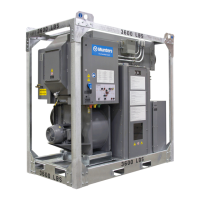Manual# I27028 4-5 Rev. 2 – 11/22/2017
It is also important that the hot, moist reactivation air not be allowed to leak back into
the conditioned space. All of the joints for the reactivation ducts must be completely
sealed.
7. After the reactivation air passes through the unit, it is very hot and can put a heat
load on the conditioned space. If any ductwork for the reactivation output air runs
through the conditioned space, insulate these sections. This will help prevent
condensation from forming inside the duct. It is also helpful to insulate the ducts for
the process output air. Seal the joints on these ducts before adding the insulation.
8. Wherever the intake or outlet ducts open outdoors, protect them from the elements.
Install weather hoods and bird screens.
9. Do not locate the intake and outlet for the process air too close together. This would
allow the dried process outlet air to be pulled into the process inlet. The machine
would be trying to dry air which has just been dehumidified (“short-cycling”).
Also allow some distance between the intake and outlet for the reactivation air. The
reactivation outlet air is very damp – do not allow it to be pulled into the reactivation
inlet. Either condition can make the unit work harder than necessary. The unit
handles large volumes of air, so try to maintain a good distance between the inlet
and outlet ducts.
4.6 GAS CONNECTIONS
1. The R-Series gas trains have been designed for either natural gas or propane.
2. The R05 units have a single main gas train (pilot-less). The R10 and R15 gas train
units have a main and a pilot gas train.
3. The main gas regulator should be adjusted to the natural gas or propane setpoint
per the instructions provided inside the gas train enclosure.
4. The R05 gas connection is 1/2” NPT and the R10 and R15 is 1” NPT.
5. The minimum gas pressure required is 15” WC and the maximum gas pressure
should not exceed 5 psi.
6. Refer to NFPA 54 for proper gas supply line sizing. Run the gas supply line in
accordance with all applicable codes.
7. A sediment trap must be provided upstream of the gas controls. Refer to NFPA 54
for sediment trap sizing.
8. All threaded joints should be coated with piping compound resistant to action of
liquefied petroleum gas and natural gas.
9. The appliance and its individual shutoff valve must be disconnected from the gas
supply piping during any pressure testing of that system at test pressures in excess
of the maximum supply gas pressure as specified on the rating plate.
10. The appliance and its gas connection must be leak tested before placing it in
operation.
11. Purge all air from gas lines prior to commissioning the equipment.
12. A 1/8” NPT side tap is located at the gas supply isolation valve, accessible for
measuring gas supply pressure.

